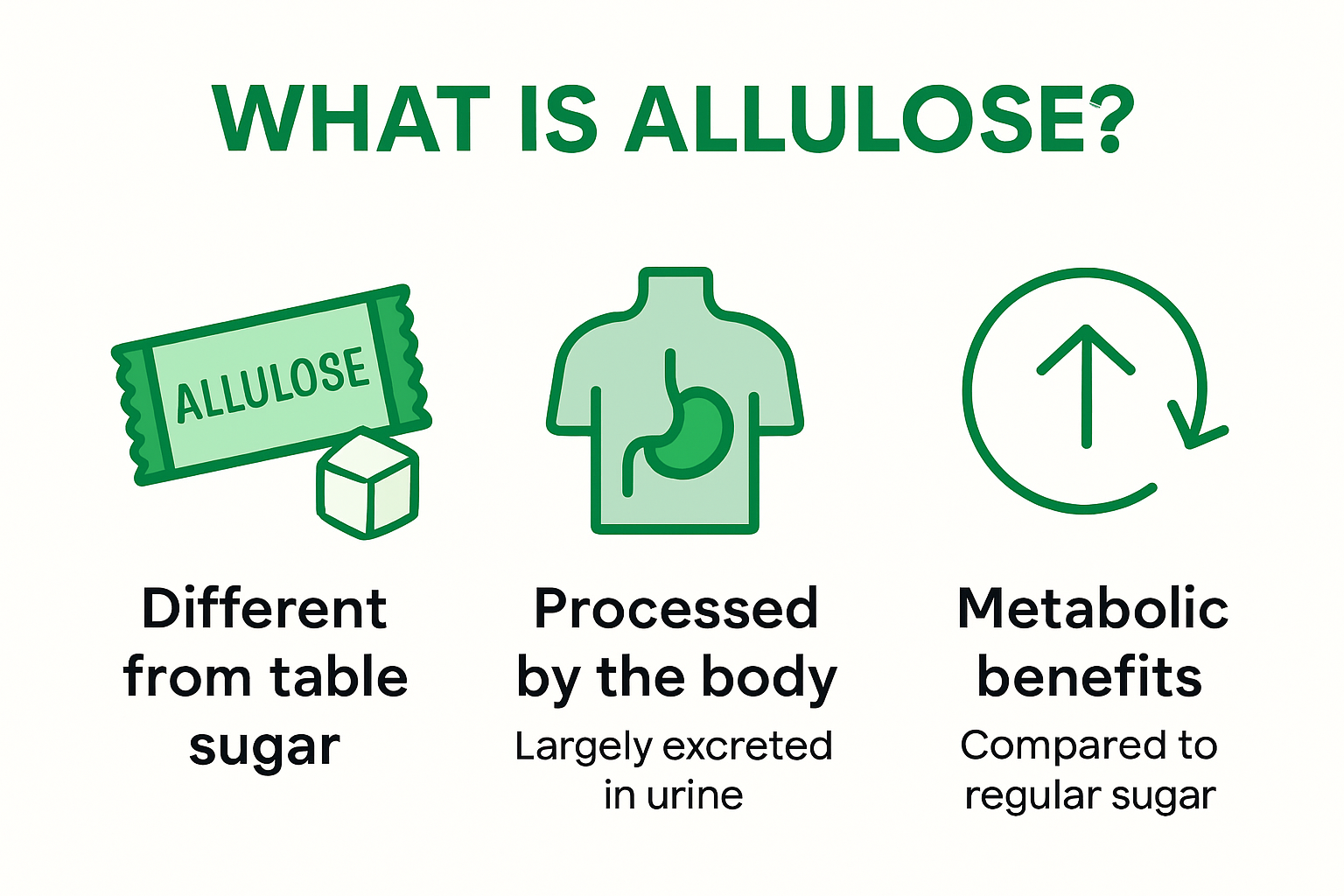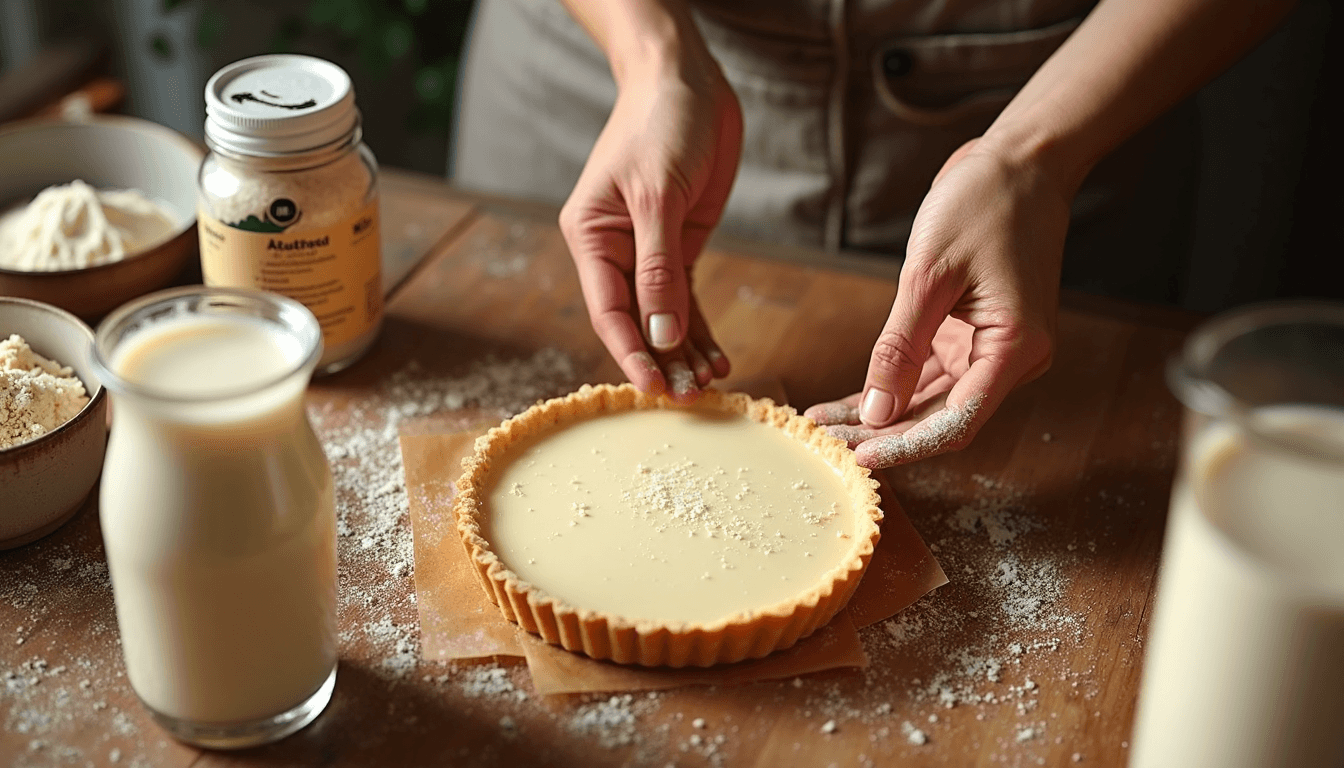
Allulose has quietly started changing how South Africans bake and cook, thanks to its ability to deliver real sweetness for just 0.2 to 0.4 calories per gram. Most people think sugar-free treats mean bland flavours or tricky substitutes that never quite work. The surprise is that allulose not only browns beautifully in the oven and keeps cakes moist, it actually helps manage blood sugar and does not raise glucose at all. Here’s why your next milk tart or malva pudding could taste even better and be better for you.
Table of Contents
- What Is Allulose And How Does It Work?
- Cooking And Baking With Allulose: Key Tips
- Health Benefits For Special Diets
- Allulose In South African Kitchens: Practical Uses
Quick Summary
| Takeaway | Explanation |
|---|---|
| Allulose is a low-calorie sweetener | Allulose offers sweetness with minimal calories (0.2 to 0.4 calories per gram), making it ideal for health-conscious individuals. |
| Adjust measurements when substituting allulose | Use about 1.3 times more allulose compared to regular sugar to achieve similar sweetness due to its approximately 70% sweetness level. |
| Allulose is heat stable | It performs well in cooking and baking, contributing to browning and maintaining its sweetening properties during heat processing. |
| Supports blood sugar management | Allulose does not raise blood glucose levels, making it beneficial for individuals managing diabetes or metabolic health. |
| Versatile in South African cuisine | Allulose can be used in traditional South African desserts and modern recipes, enhancing dishes without sacrificing flavour or texture. |
What Is Allulose and How Does It Work?
Allulose represents an exciting breakthrough in natural sweetening technology, offering a unique solution for health-conscious individuals seeking low-calorie alternatives. This rare sugar, scientifically known as D-psicose, emerges as a proper game-changer in the world of dietary sweeteners.

The Molecular Magic of Allulose
At its core, allulose is a rare sugar molecule naturally occurring in small quantities in select foods like wheat, figs, and molasses. According to research from the FDA, this sugar has a remarkable metabolic profile that sets it apart from traditional sweeteners. Unlike regular sugars that get metabolised and contribute calories, allulose passes through the body virtually unnoticed.
The molecular structure of allulose is what makes it extraordinary. While it looks and tastes similar to table sugar, it is absorbed by the small intestine but not metabolised for energy. Scientific studies from PubMed indicate that this unique pathway means allulose does not raise blood glucose or insulin levels, making it an exceptional option for individuals managing their metabolic health.
How Allulose Works in Your Body
When you consume allulose, something fascinating happens. Researchers at Healthline confirm that approximately 70% as sweet as sucrose, it provides only 0.2 to 0.4 calories per gram. This means you get the sweetness you crave without the significant caloric impact. Your body essentially processes allulose differently - it gets absorbed in the small intestine but is quickly excreted in urine, leaving minimal metabolic footprint.
Moreover, emerging research suggests potential additional benefits. Some studies hint at allulose potentially enhancing postprandial fat oxidation, which could have interesting implications for energy metabolism and weight management. Our comprehensive guide on allulose glycemic impact provides deeper insights into how this remarkable sweetener interacts with your body’s metabolic processes.
For South African health enthusiasts looking to make smarter dietary choices, allulose represents more than just a sweetener. It’s a sophisticated molecular solution that allows you to enjoy sweetness without compromising your nutritional goals. Whether you’re managing blood sugar, watching calories, or simply seeking a more intelligent sweetening option, allulose stands out as a remarkable innovation in nutritional science.
The beauty of allulose lies in its simplicity - a sugar that acts unlike any other, offering sweetness without the metabolic complications of traditional sugars. It’s not just a sweetener; it’s a metabolic marvel.

Cooking and Baking With Allulose: Key Tips
Mastering allulose in your kitchen requires understanding its unique properties and nuanced behavior during cooking and baking. Unlike traditional sugar, this rare sweetener demands a strategic approach to achieve optimal results in your culinary adventures.
Understanding Allulose Heat Stability
Allulose stands out for its remarkable heat stability, making it an exceptional ingredient for various cooking applications. According to research published in Food Science, allulose contributes to browning through Maillard reactions, similar to traditional sugars, while maintaining its low-calorie profile. This means you can achieve that golden-brown crust in baked goods without the metabolic consequences of regular sugar.
When heating allulose, you’ll notice some fascinating characteristics. Scientific studies from the National Institutes of Health confirm that it remains stable during heat processing, making it suitable for a wide range of cooking techniques. Whether you’re caramelizing, baking, or creating sauces, allulose performs admirably without breaking down or losing its sweetening properties.
Practical Baking and Cooking Substitution Tips
Substituting allulose in recipes requires a bit of culinary finesse. Researchers exploring baking applications have discovered that allulose impacts the physicochemical properties of baked goods differently from traditional sugar. For optimal results, consider these practical tips:
- Measurement Matters: Allulose is approximately 70% as sweet as sugar, so you’ll need to adjust quantities. Generally, use about 1.3 times more allulose compared to regular sugar to achieve similar sweetness.
- Moisture Management: Allulose can enhance moisture retention in baked goods. You might need to slightly reduce other liquid ingredients to maintain the right texture.
- Browning Adjustment: While allulose browns similarly to sugar, you may want to lower baking temperatures slightly to prevent over-caramelization.
Our comprehensive guide to easy allulose recipes offers detailed insights into successfully incorporating this sweetener into your favorite dishes.
South African home bakers and health-conscious cooks will appreciate allulose’s versatility. From traditional milk tart to modern low-carb desserts, this sweetener opens up a world of culinary possibilities. You can create lekker treats that satisfy your sweet tooth without compromising your nutritional goals.
Remember that practice makes perfect. Each recipe might require slight modifications, so don’t be afraid to experiment. Start with recipes specifically designed for allulose, then gradually adapt your favorite traditional recipes. The key is patience and a willingness to learn how this remarkable sweetener behaves in different cooking scenarios.
Whether you’re whipping up a rooibos-infused cake or creating a sugar-free malva pudding, allulose provides a sophisticated sweetening solution that aligns with modern health-conscious cooking approaches.
To help guide you through baking and cooking with allulose, here’s a practical table summarizing some key substitutions and adjustments mentioned above:
Here’s a table to help you quickly reference the main substitution tips and adjustments when using allulose in recipes:
| Tip | Why It Matters | Suggested Adjustment |
|---|---|---|
| Sweetness Compensation | Allulose is less sweet than sugar | Use 1.3x more allulose than sugar |
| Moisture Adjustment | Retains more moisture than sugar | Reduce other liquids slightly |
| Browning/Cooking Temperature | Browns/caramelises quicker | Lower baking temp by ~5-10°C if needed |
| Texture Management | Different mouthfeel or softness | Monitor overall dough/batter consistency |
| Recipe Specificity | Some recipes respond differently | Start with allulose-based recipes first |
Health Benefits for Special Diets
Allulose emerges as a nutritional powerhouse for individuals following specialized dietary regimens, offering unique metabolic advantages that extend far beyond traditional sweeteners. Its remarkable properties make it an exceptional choice for health-conscious South Africans seeking intelligent nutritional solutions.
Blood Sugar Management and Metabolic Health
Research from clinical studies reveals that consuming 5 to 10 grams of allulose can significantly reduce postprandial blood glucose levels in healthy individuals. This finding is particularly crucial for people managing diabetes or metabolic conditions. Our comprehensive diabetic-friendly foods guide provides deeper insights into how allulose can support balanced blood sugar management.
Moreover, scientific investigations on diet-induced obese models demonstrate that allulose supplementation leads to remarkable metabolic improvements. Studies showed reduced body weight gain and enhanced insulin sensitivity, suggesting profound potential for individuals struggling with obesity and type 2 diabetes.
Weight Management and Nutritional Strategies
Allulose presents a sophisticated approach to weight management. Comprehensive research published in metabolic journals indicates that allulose consumption can decrease body weight and reduce abdominal fat mass more effectively than certain traditional interventions. For individuals following ketogenic, low-carb, or calorie-restricted diets, this represents a significant breakthrough.
Key benefits for specialized diets include:
- Zero Glycemic Impact: Allulose does not raise blood sugar levels, making it ideal for diabetic and low-carb dietary approaches.
- Minimal Caloric Contribution: With approximately 0.4 calories per gram, it supports weight management goals.
- Natural Metabolic Support: Helps maintain metabolic flexibility without compromising dietary objectives.
To better understand the health benefits for special diets, here’s a table summarizing key metabolic impacts and nutritional advantages of allulose mentioned above:
| Benefit | Description | Supporting Information |
|---|---|---|
| No Blood Sugar Spike | Does not raise blood glucose or insulin levels | Safe for diabetes and metabolic health |
| Low Calorie Content | 0.2-0.4 calories per gram | Ideal for calorie-conscious individuals |
| Weight Management Support | May decrease body weight and abdominal fat | Beneficial for weight loss diets |
| Metabolic Flexibility | Does not disrupt metabolic processes | Supports low-carb and keto diets |
| Natural Occurrence | Found in foods like wheat, figs, and molasses (small amount) | Offers a natural rare-sugar option |
For South African health enthusiasts exploring intelligent nutritional strategies, allulose represents more than a sweetener. It’s a nuanced metabolic tool that supports diverse dietary needs without compromising taste or satisfaction. Whether you’re managing diabetes, pursuing weight loss, or seeking a sophisticated low-carb solution, allulose offers a remarkable pathway to achieving your health goals.
The beauty of allulose lies in its ability to integrate seamlessly into various dietary frameworks. It’s not just about reducing sugar intake it’s about enhancing metabolic resilience and providing a smarter approach to nutrition. As research continues to unveil its potential, allulose stands at the forefront of innovative dietary solutions for the health-conscious individual.
Allulose in South African Kitchens: Practical Uses
South African culinary traditions are experiencing a delightful transformation with the introduction of allulose, a rare sugar that promises to revolutionize how we approach sweet creations. From traditional desserts to modern health-conscious recipes, this innovative sweetener is making waves in kitchens across the country.
Reimagining Traditional South African Desserts
Imagine transforming beloved classics like malva pudding, milk tart, and koeksisters with a healthier twist. Allulose offers South African home cooks an opportunity to reinvent these cherished recipes without compromising on taste or texture. Our easy allulose recipe collection provides expert guidance on adapting traditional treats to this revolutionary sweetener.
Research highlighting allulose’s functional properties confirms its remarkable ability to mimic sugar’s browning and textural characteristics. This means you can create a perfectly caramelized malva pudding or a golden-brown milk tart crust using significantly fewer calories. The molecular magic of allulose allows it to perform similarly to sugar while offering substantial health benefits.
Versatile Culinary Applications
Beyond desserts, allulose proves incredibly versatile in South African cooking. Whether you’re preparing a rooibos-infused cake, a low-carb bobotie, or creating sugar-free preserves, this sweetener adapts beautifully. Its approximately 70% sweetness compared to regular sugar means you’ll need slight recipe adjustments, but the results are consistently impressive.
Key practical applications include:
- Baking: Perfect for cakes, cookies, and pastries
- Beverages: Excellent in smoothies, coffee, and tea
- Preserves: Ideal for jams and chutneys
- Sauces: Great for marinades and glazes
Experts recommend understanding allulose’s safety profile before extensive use, ensuring you’re making informed dietary choices. The sweetener’s unique metabolic pathway means it doesn’t impact blood sugar levels, making it particularly attractive for health-conscious South Africans.
Local health enthusiasts and culinary adventurers are discovering that allulose is more than just a sugar substitute it’s a nutritional game-changer. Whether you’re managing diabetes, following a low-carb lifestyle, or simply seeking a smarter sweetening option, allulose offers a lekker solution that doesn’t compromise on flavor.
As South African kitchens continue to embrace innovative ingredients, allulose stands out as a remarkable addition. It represents the perfect blend of traditional cooking passion and modern nutritional science a true reflection of our nation’s culinary creativity and commitment to healthier living.
Frequently Asked Questions
Can I use allulose for baking and cooking?
Yes, allulose is heat stable and works well in baking and cooking. It browns similar to traditional sugar and maintains its sweetening properties during heat processing.
How do I substitute allulose for sugar in recipes?
To substitute allulose for sugar, use about 1.3 times more allulose than the amount of sugar called for in the recipe, since it is approximately 70% as sweet as sugar.
Does allulose affect blood sugar levels?
No, allulose does not raise blood glucose or insulin levels, making it a safe sweetener option for individuals managing diabetes or metabolic health.
What are the health benefits of using allulose?
Allulose provides minimal calories (0.2 to 0.4 calories per gram), supports weight management, and helps manage blood sugar levels, making it a beneficial choice for health-conscious individuals.
Bring Safe, Delicious Sweetening Home with Allulose
Discovering the secret to guilt-free, golden-baked treats and healthy, sugar-conscious living is now easier than ever. If you are searching for a way to cook and bake without worrying about blood sugar spikes or the funny aftertaste that comes with artificial sweeteners, Allulose - Allulo has exactly what you need. Enjoy everything you love about real sugar with none of the compromise. Start using a natural ingredient that keeps your cakes moist, caramelizes like the real thing, and supports your health goals.

Take the next step to a healthier kitchen and explore more recipes, trusted nutritional resources, and a full range of premium allulose options at Allulo.co.za. Stock up today and reimagine your favourite South African desserts the smart way before everyone else does. Your perfect, safe sweetening solution is waiting for you right now.
Recommended
- Is Allulose Safe? The Truth for Health-Conscious South Africans (2025) - Allulo
- Allulose Recipes Easy: Healthy & Guilt-Free Sweets for 2025 - Allulo
- Allulose and Digestion: Safe Sweetening for Health-Conscious South Africans 2025 - Allulo
- Allulose Glycemic Index: Guide for Healthy Sugar Swaps 2025 - Allulo
- Are Sugar Alcohols Healthy? Safe Choices for South Africans 2025 - Allulo
- Easy Sugar Alternatives for Healthy South African Living 2025 - Allulo


